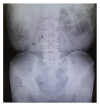Laparoscopic Repair of Internal Transmesocolic Hernia of Transverse Colon
- PMID: 26246930
- PMCID: PMC4515260
- DOI: 10.1155/2015/853297
Laparoscopic Repair of Internal Transmesocolic Hernia of Transverse Colon
Abstract
Introduction. Internal hernias are often misdiagnosed because of their rarity, with subsequent significant morbidity. Case Presentation. A 61-year-old Japanese man with no history of surgery was referred for intermittent abdominal pain. CT suggested the presence of a transmesocolic internal hernia. The patient underwent a surgical procedure and was diagnosed with transmesocolic internal hernia. We found internal herniation of the small intestine loop through a defect in the transverse mesocolon, without any strangulation of the small intestine. We were able to complete the operation laparoscopically. The patient's postoperative course was uneventful and the patient was discharged on postoperative day 6. Discussion. Transmesocolic hernia of the transverse colon is very rare. Transmesocolic hernia of the sigmoid colon accounts for 60% of all other mesocolic hernias. Paraduodenal hernias are difficult to distinguish from internal mesocolic transverse hernias. We can rule out paraduodenal hernias with CT. Conclusion. The patient underwent a surgical procedure and was diagnosed with transmesocolic internal hernia. We report a case of a transmesocolic hernia of the transverse colon with intestinal obstruction that was diagnosed preoperatively and for which laparoscopic surgery was performed.
Figures




References
-
- Meyers M. A., Charnsangavej C., Oliphant M. Meyers' Dynamic Radiology of the Abdomen Normal and Pathological Anatomy. 6th. New York, NY, USA: Springer; 2011.
-
- Sunami E., Suzuki S., Mishina T. A case of transmesocolonic hernia in the mesentery of transverse colon. The Japanese Journal of Gastroenterological Surgery. 2004;37(8):1491–1496. doi: 10.5833/jjgs.37.1491. - DOI
-
- Crispín-Trebejo B., Robles-Cuadros M. C., Orendo-Velásquez E., Andrade F. P. Internal abdominal hernia: intestinal obstruction due to trans-mesenteric hernia containing transverse colon. International Journal of Surgery Case Reports. 2014;5(7):396–398. doi: 10.1016/j.ijscr.2014.01.013. - DOI - PMC - PubMed
LinkOut - more resources
Full Text Sources
Other Literature Sources

